Sanliurfa Travel Guide 2024
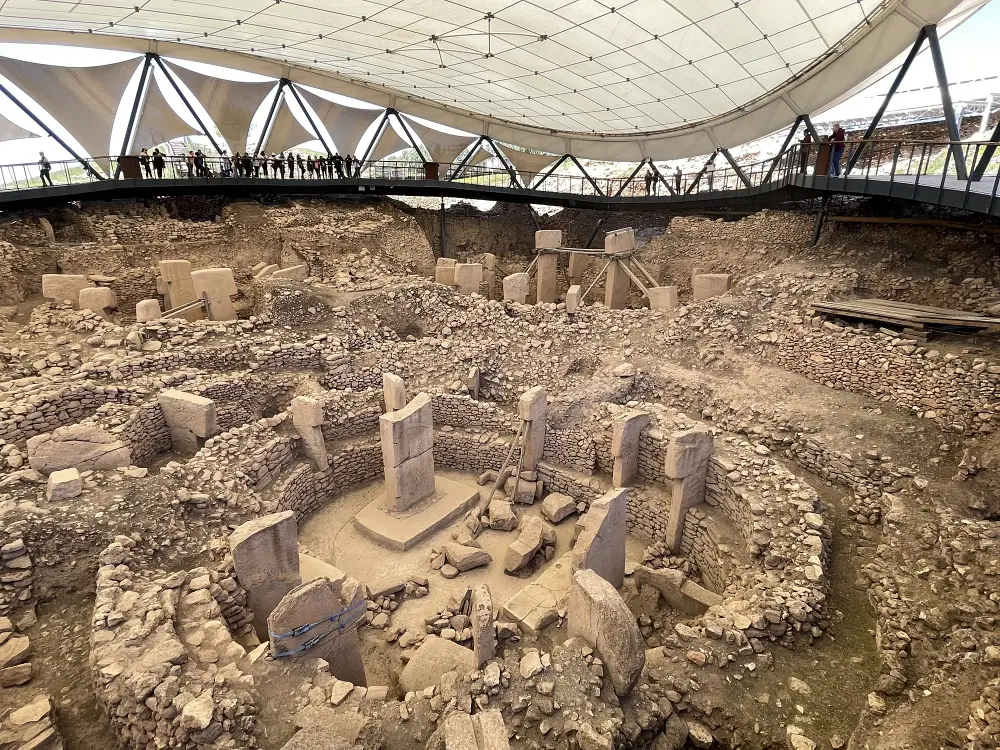
THE PLACE WHERE EVERYTHING BEGAN: SANLIURFA
It’s a center of faith, as shown by the temples of three Abrahamic religions, a center of trade. It is indicated by its markets and bazaars, and a center of education, evidenced by its madrasahs. This is Sanliurfa. You’ll admire its cuisine and while sipping the bitterest coffees. Those with a different flavor, you’ll find spiritual peace. Do you wonder when ramadan 2025 is?
Now, you are in the lands of Gobeklitepe, the zero point of history. Birecikis home to the endangered bald ibis. Harran Plain is the place where agriculture began. Balikligol is believed to have formed due to the casting of Prophet Abraham into fire.
Sanliurfa, as recent archaeological excavations have shown, is one of the world’s oldest cities, almost like the motherland of humanity. The Syrian historian Abu’l Faraj states that Sanliurfa was the first of the seven settlements established on earth after the Noah’s Flood. With the excavations in Gobeklitepe, human history is being rewritten, changing what is known.
Sanliurfa, having been a settlement since prehistoric times, is naturally the homeland of many firsts. The Balikligol Statue is the oldest human-sized sculpture. Urfa Man is 11,500 years old. It is much older than the Pyramids and Stonehenge, with eyes made of obsidian, witnesses history. Gobeklitepe is one of the most important archaeological discoveries of the century. It rewrites the history of religions, art and architecture, agriculture, and domestication of animals.
In this oldest city in the world, at the zero point of history, let’s embark on a journey through the land of prophets, temples, madrasahs, museums, and species under the threat of extinction.
THE ORIGIN OF THE NAME URFA
The title “Sanli” was given by the Grand National Assembly of Turkey. They gave that name for the heroism of its people during the National Struggle. The city’s name, Urfa, is thought to have originated from the Syriac “Urhai,” meaning “wet place”. The city, later called “Ur,” was named “Edessa” after the arrival of Alexander the Great. He was inspired by a river in Greece. This name, like the Greek name “Kallirhoe,” which means “beautiful streams” and was used for this ancient city, and “Ruha”. It was used mistakenly by the Arabs for “Kallirhoe,” emphasizes the city’s close connection with water. In Turkish, the name is Şanlıurfa.
THE ZERO POINT OF HISTORY: GOBEKLITEPE
Excavations and Prof. Schmidt
Gobeklitepe is known as the “zero point of history“. It was added to the UNESCO World Heritage List in 2018. 2019 was declared the “Year of Gobeklitepe” in Turkey. Gobeklitepe is a site that has reshaped the understanding of world and human history. It has been widely discussed in numerous publications, articles, and research, being the oldest known worship center.
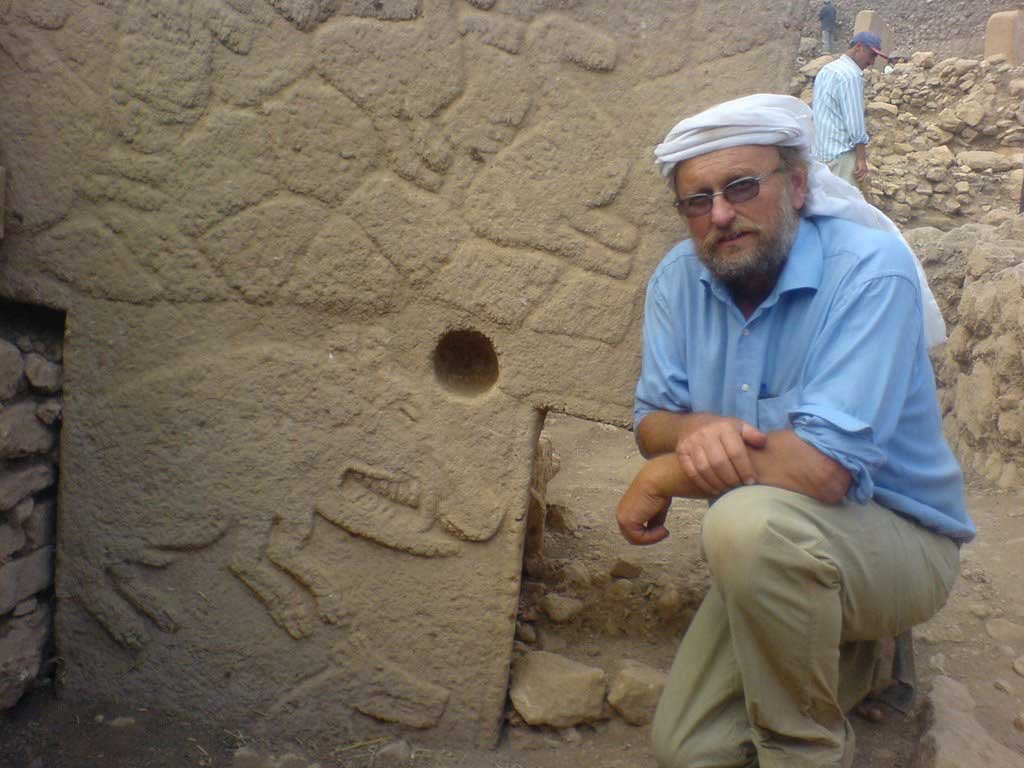
This monumental site challenges the widely accepted theory that religions emerged after the transition to settled life. Instead, it suggests that religion played a significant role in the shift towards settled living. Only a limited portion of these prehistoric remains in the Harran Plain excavated. However, the extraordinary findings have invalidated many previously held beliefs about the Neolithic Age.
Gobeklitepe is located near the village of Orencik in Sanliurfa. The ancient site gained international recognition through the work of German Archaeologist Prof. Klaus Schmidt. His excavations started in 1995 and continued until his death in 2014. The excavations revealed that it was a Stone Age temple, a fact first recognized by Prof. Schmidt.
T Shapes or The Oldest Human Statues
The most striking discoveries at Gobeklitepe are the T-shaped stone blocks. All researchers agree that these blocks, some of which have hand and finger shapes and reach up to 6 meters in height and number around 40, symbolize humans.

At Gobeklitepe, which carries information from 12,000 years ago to the present, symbolic expression especially peaks in Temple D. There are also reliefs of foxes, leopards, bulls, snakes, cranes, wild boars, spiders, and gazelles. What do these oldest shaped thoughts in the world tell us?
A Pilgrimage Site for Stone Age People?
Scans conducted at Gobeklitepe have identified at least 20 areas with diameters ranging from 20 to 30 meters, used for worship purposes. So far, seven of these have been uncovered, named as Structures A, B, C, D, E, F, and G. Archaeological research indicates that Gobeklitepe was a site where people from the Neolithic period gathered at specific times for worship, essentially serving as a pilgrimage site.
The World’s Oldest Center of Belief
Gobeklitepe, unlike nearby settlements such as Nevali Cori, Karahan tepe, Sefer Tepe, and Hamzantepe, Boncuklu Tarla, was built specifically for worship and is situated on the peak of the surrounding area’s highest hill. Used until around 8000 BC, the reasons for Gobeklitepe’s abandonment, why it wasn’t repurposed for other or similar objectives, and why it was deliberately buried are among the most intriguing questions in the scientific community.
Interestingly, even before the temple was discovered, the area of Gobeklitepe was considered sacred, a place where people would come to sacrifice animals, make vows, and pray.
The Birthplace of Painting, Sculpture, and Architecture
The 12,000-year-old structures found at Gobeklitepe are considered the beginning of architectural history. Built with limestone extracted from quarries 2 km away, Gobeklitepe represents an awe-inspiring effort considering the conditions of the era in which it was constructed.
The T-shaped pillars at Gobeklitepe, adorned with reliefs of wild animals, are among the oldest known examples of sculpture and painting arts discovered to date.
Sanliurfa in the Neolithic Period
Balikligol Statue
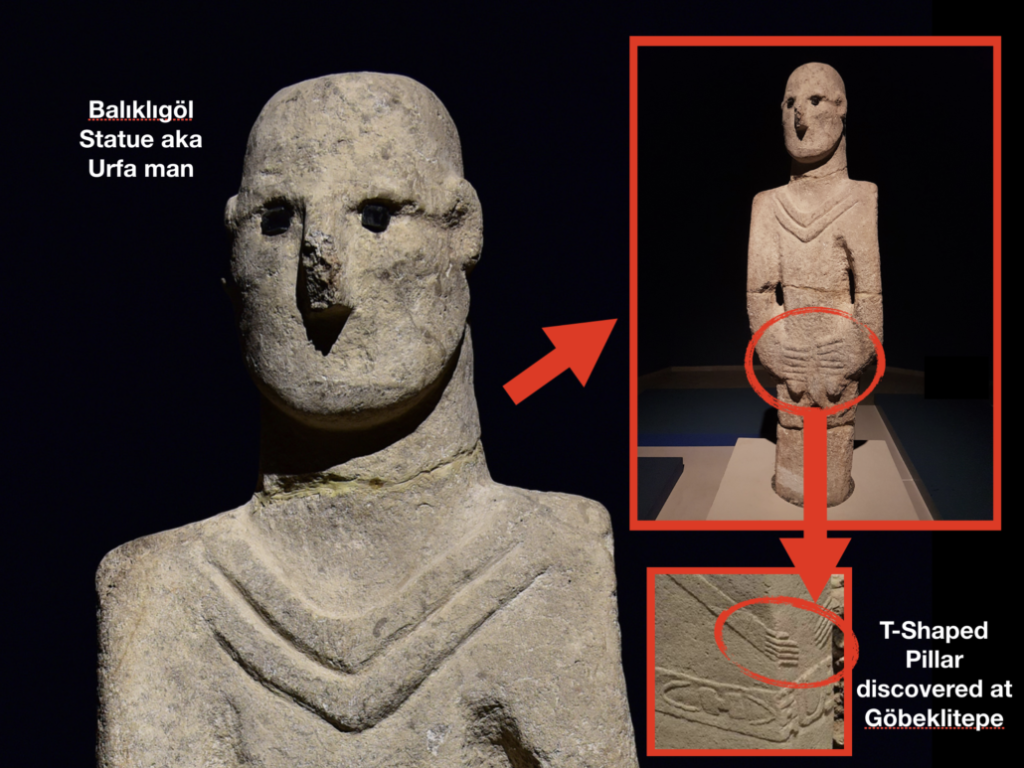
The “Urfa Man” also known as the Balikligol Statue, dating back to the same period as Gobeklitepe and about 11,500 years old, is the oldest known life-sized human statue discovered so far. Displayed in the Sanliurfa Archaeology Museum, this 1.8-meter-tall statue has eyes made of obsidian and is notable for its decorative elements, serving as a witness to history.
Karahantepe

Located within the boundaries of the Tektek Mountains National Park, about 60 km southeast of Gobeklitepe, Karahantepe is considered a potential “New Gobeklitepe” Like Gobeklitepe, Karahantepe houses T-shaped structures and various animal statues, including one resembling the Balikligol Statue. As an area still in the early stages of excavation, Karahantepe is a site where archaeologists hope to gain significant insights into this period.
Çori and Other Neolithic Settlements
Nevali Çori, located in the Gulsugagi neighborhood of the Hilvan district, is a settlement that provides significant information about hunter-gatherers of the Neolithic Period. Today, the site is submerged under the waters of a dam, and the artifacts recovered are displayed in the Sanliurfa Archaeology Museum.
Other important Neolithic settlements unearthed in Sanliurfa include Hamzantepe in the Siverek district, Sefer Tepe in the Viransehir district, Harbetsuvan Tepesi, located 55 km south of Gobeklitepe, and Tel Idris Mound in Harran.
The Land of Prophets: Şanlıurfa
Cave of the Birth of Prophet Abraham

Many sites in Sanliurfa are associated with Prophet Abraham. It is believed that Prophet Abraham was born in a cave south of the courtyard of the Mevlid-i Halil Mosque. According to legend, the ruler of the time, Nimrod, had a dream interpreted by astrologers. They told him that a child born that year would end his reign. The tyrant ruler then ordered the execution of all male children born that year. Azer’s wife, responsible for the maintenance of the idols in the palace, secretly gave birth to Abraham in this cave. Accordingly, Prophet Abraham lived in this cave for a while. Additionally, the water inside the cave is believed to be healing and beneficial for many diseases.
Halil-ur-Rahman Lake (Balikligol) and Aynzeliha Lake (Anzilha Lake)
Prophet Abraham opposed idol worship and advocated the belief in one God. He was catapulted into the fire by the tyrant ruler Nimrod. The fire miraculously turned into a lake, and the logs into fish. This event is described in the Quran: “O fire, be coolness and safety upon Abraham” (Quran 21/69). People believe that Halil-ur-Rahman Lake formed as a result of this miracle. The fish in the lake are considered sacred and protected by the local people.
Next to Balikligol, in front of the Sanliurfa Castle, lies the small Aynzeliha Lake, spanning an area of 150 square meters. There is a belief that this lake formed when Nimrod’s daughter Zeliha, who professed her belief in Prophet Abraham’s religion, was thrown into the fire by her father as Abraham was about to be cast into the fire. According to this belief, just as with Prophet Abraham, a lake formed where Zeliha fell, and hence the lake was named Aynzeliha, which means ‘Spring of Zeliha’ in Arabic.
The Ancient City of Shuayb
Located east of Harran, this ancient city dates back to the Late Roman Period. It is believed that Prophet Shuayb lived in a cave here. This abandoned ancient city, where stunning photographs can be taken, is one of the must-visit places in Sanliurfa.
Well of Prophet Jacob

Located north of the Sheikh Hayat al-Harrani Tomb, this is a significant site for locals and visitors to Harran. According to the Old Testament, Prophet Jacob, fleeing his brother’s enmity, arrived in Harran, where he saw his uncle Laban’s daughter Rachel while chatting with shepherds at a well and fell in love with her. To marry Rachel, he worked for 14 years without pay for his uncle.
Eyyubnebi Village
Located in the Viransehir district, this pilgrimage site houses the tombs believed to belong to Prophet Job, known for his trials and patience, his wife Rahime Hatun, and Prophet Elisha. A large basalt stone, believed to be where Prophet Job aged, is also an important preserved artifact. The cave where Prophet Job suffered his illness and the well from which he bathed and drank for healing are located in the Eyyubiyeh district.
The Land of Temples: Sanliurfa
Sin Temple
The 3,000-year-old Sin (Moon) Temple in the Basbug neighborhood of Siverek district in Sanliurfa dates back to the Late Assyrian Period. This site is one of the most important surviving examples of Sabianism and Moon worship, ancient beliefs of Mesopotamia. Sabianism, with its many secrets and reflections in celestial religions, continues to intrigue researchers today. This ancient temple is a must-see for visitors to Sanliurfa.
Reji Church (Saint Peter and Saint Paul Church) in Sanliurfa

Built in 1861 on the site of a 1st-century church ruin, the Saint Peter and Saint Paul Church is located in Ellicekez Square. Named after Jesus Christ’s two apostles, the church was used by the Tobacco Regie after the departure of Syriacs from Sanliurfa to Aleppo, hence acquiring the name ‘Reji,’ meaning administration. Tombstones removed from the church are displayed in the Sanliurfa Archaeology Museum. The building now hosts various events.
Deyr-i Yakup (Jacob Monastery)
Deyr-i Yakup or Jacob Monastery, dating back to the late 2nd and early 3rd centuries, is located 10 km from the city center. The site is also known as “Nemrut’s Throne” as it is believed to have been used as a resort area by King Nemrut, who confronted Prophet Abraham. An inscription, with the first line in Greek and the second in Palmyrene Syriac, is found under a window facing east.
Firfirli Mosque
(Church of the Twelve Apostles, Church of the Holy Apostles)
Located on Governor Fuat Bey Street in the city center, it was originally known as the Church of the Twelve Apostles before being converted into a mosque. Its historical significance includes hosting the Varak Cross brought from Varak Monastery in Van in 1092. During the Ottoman Period, the building was called “Firfirli Church” due to windmill-like structures on it, and the same name was later given to the mosque. The architecture, particularly its half-columns and exterior decorations, is noteworthy.
Halil-ur-Rahman Mosque (Doseme Mosque)
Located beside Balikligol, also known as the “Doseme Mosque” among locals. It was built as a church in honor of the Virgin Mary in 504 during the Byzantine Period. The church was converted into a mosque during the Abbasid Caliphate under Caliph Al-Ma’mun. Preserved during the Ottoman Period, the complex includes a mosque, madrasa, cemetery, and the site where Prophet Abraham is believed to have fallen into the fire.
Salahaddin Eyyubi Mosque
(Saint John the Baptist Addai Church)
Originally a Byzantine structure, it was known as “Saint John the Baptist Church.” Being the largest church in the area, it was also referred to as a “cathedral.” The dilapidated church was rebuilt by the Armenians of Urfa in 1849, stood vacant for a while after the Armenians left the city, and was converted into a mosque in 1993. It is located on Governor Fuat Bey Street in the city center.
Rizvaniye Mosque
Located on the north side of Balikligol, it was built in 1736 by the Governor of Raqqa, Ridvan Ahmed Pasha. Notable for its architecture, the mosque has three domes. The wooden door, made without nails using fitting and inlay techniques, features rich vegetal and geometric patterns.
Mevlid-i Halil Mosque
Located near Balikligol, the Mevlid-i Halil Mosque is named after the nearby cave believed to be the birthplace of Prophet Abraham. Initially built as a pagan temple during the Seleucid Era, it served as a synagogue and then as a church in early Christianity. A mosque was built on the site during the Ottoman Period, where the Urfa Hagia Sophia once stood.
Hasan Pasa Mosque
Located near Balikligol, this mosque was built in the second half of the 15th century by Uzun Hasan, ruler of the Akkoyunlu dynasty. Water from Balikligol flows through the courtyard of this mosque. In Evliya Celebi’s ‘Book of Travels,’ it is referred to as “Sultan Hasan Mosque.”
Dabakhane Mosque
Located in the city center, the Dabakhane Mosque was built during the Ottoman Era, in the year 1568, under the reign of Sultan Selim II. It is exceptional for its mükkebire section above the entrance door, which functioned to project the imam’s voice through plaster.
Nimetullah Mosque (White Mosque)
The Nimetullah Mosque is situated in the Nimetullah neighborhood, Ellicekiz Square. Inscriptions on this 16th-century structure indicate that it was converted from an old and dilapidated church into a mosque. The door leading to the main worship area showcases fine examples of classical Ottoman style.
Mevlevihane Mosque
Located in Hasimiye Square, this building was constructed as a Mevlevi lodge (Mevlevihane) in the 18th century. After the closure of Sufi lodges, it was converted into a mosque. The market attached to the west facade of the building, originally a butchers’ market, has since been transformed into a market selling souvenirs.
Haci Yadigar Mosque
It is situated on Güllüoğlu Street in Türkmeydanı neighborhood. This historic mosque’s eight-line inscription on its inner door reveals that it was built in 1155 and renovated in 1514. It is one of the oldest mosques in the city.
Ulu Mosque (Saint Stephan Church) and Clock Tower in Sanliurfa

The mosque is on Divanyolu Street in the city center. It was built on the site of a former church known as the “Red Church” Remnants of the old structure, including courtyard walls, columns, capitals, and the bell tower, can still be seen. Dating back to the 12th century and the Zengid period, the Ulu Mosque is also known as “Masjid al-Hamra (Red Mosque)” due to its red marble columns and its connection to the church.
The mosque’s prayer area contains a well. According to local belief, the handkerchief sent by Jesus Christ through Apostle Thomas to King Abgar was placed in this well. The minaret was converted into a clock tower during the Republican era, making it city’s first and only clock tower
Prophet Mosque (Circis Prophet Mosque)
Believed to be built in the name of Prophet Circis, the Prophet Mosque is located in Kamberiye neighborhood, adjacent to the Mufti’s office. This building, which was outside the walls of Sanliurfa at the time of its construction, is regarded as the site of Prophet Circis. It is one of the churches that were converted into mosques, with one of its inscriptions in Syriac.
Harran Ulu Mosque in Sanliurfa
It is one of the significant works of the Islamic Period. Harran Ulu Mosque or Jannat Mosque is on the northeastern slope of the Harran Mound. The mosque still preserves its eastern facade, mihrab, ablution fountain, and most of its minaret. It holds titles such as the first monumental mosque built in Anatolia, the largest mosque. The mosque has a porticoed courtyard, and the richest in stone ornamentation. It was Constructed between 744-750 AD during the Umayyad Caliphate under Caliph Marwan II. The mosque holds a significant place in Anatolian mosque architecture.
Imam Bakir Mosque and Tomb
Located in Imam Bakir village, about 3 km northeast of Harran, the complex consists of a tomb attributed to Abu Jafar Imam Muhammad al-Bakir, the fifth of the Twelve Imams, and a mosque bearing his name.
From the Dark Ages to Present-Day Sanliurfa: Museums
Sanliurfa Museum
The Sanliurfa Archaeology and Mosaic Museum holds the title of “Turkey’s largest museum”. It is of international importance for the Neolithic period and houses artifacts from Gobeklitepe. Gobeklitepe is considered the century’s most significant archaeological discovery. It is among numerous historically valuable settlements, mounds, and ruins. The museum in Sanliurfa is among the world’s leading museums with its rich collection. Besides artifacts from Harran and its surroundings, which have been continuously inhabited from 3000 BC to the 15th century AD, the museum also displays finds from rescue excavations at sites like Nevali Çori, now submerged under dam waters. The museum notably hosts the reconstructed Nevali Çori Temple, which was relocated to prevent its submersion.
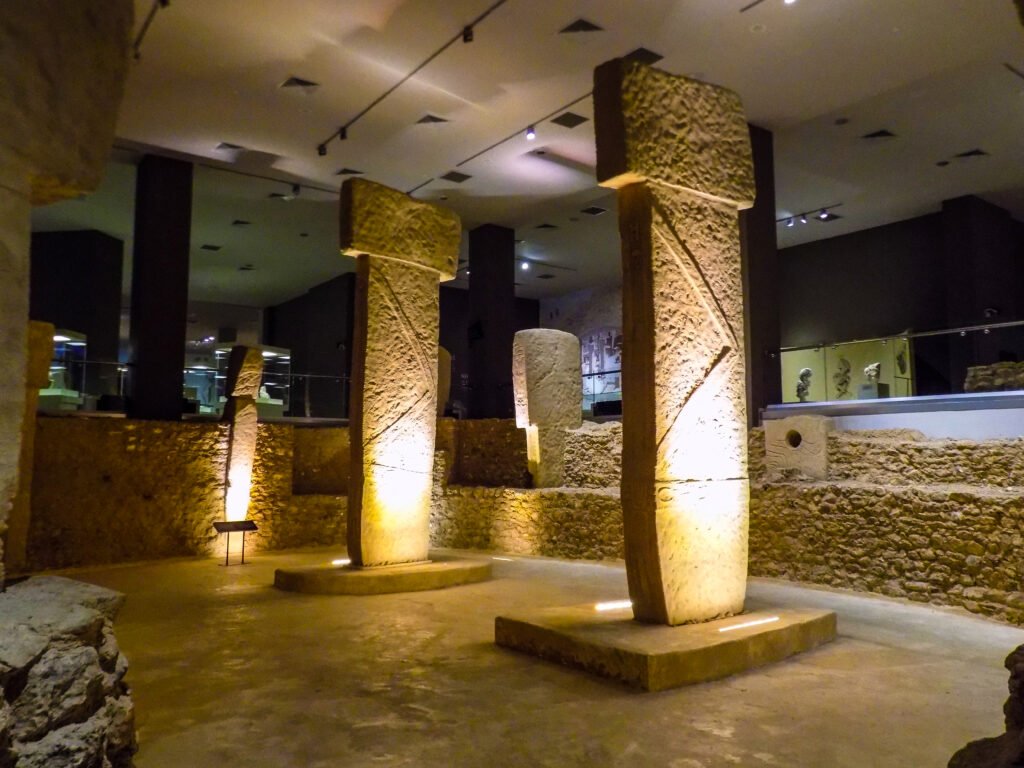
The museum operates with 14 main exhibition halls and 33 reconstruction sections. Its Archeopark area features chronologically arranged architectural examples reflecting the period’s characteristics and an experimental archaeological training area. Exhibits include artifacts from the Paleolithic period, the “Balikligol Man” (the oldest human-sized statue dated to the Neolithic period), Gobeklitepe findings, the Nevali Çori Temple, and artifacts from the Chalcolithic, Bronze, Iron, Hellenistic, Roman, Byzantine, and Islamic periods.
Sanliurfa Haleplibahce Mosaic Museum
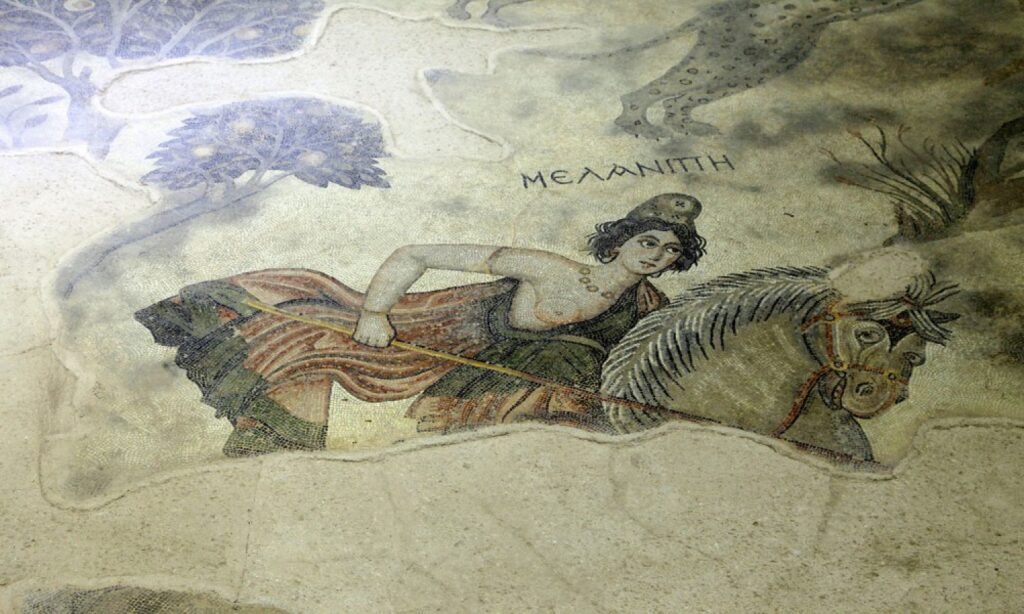
Built on the site where floor mosaics were discovered during excavations in the Haleplibahce area, the Sanliurfa Mosaic Museum hosts a range of unique mosaics. Among its precious mosaics are those depicting warrior Amazon queens and hunting scenes of Amazons, renowned female warriors in mythology. Particularly notable are the Achilles Mosaic, depicting the life story of Achilles, a hero of the Trojan War, and the Orpheus Mosaic, dated to 194 AD. The excavations in Haleplibahce also revealed a Roman-era floor-heated bath, underscoring the area’s significance as a settlement.
Sanliurfa Liberation Museum (Mahmud Nedim Mansion)
Built in 1903, the mansion showcases a blend of European-style mansion architecture and traditional Urfa house architecture. Used as a headquarters during the French occupation, bullet marks from liberation militia can still be seen on its walls. It opened as the “Sanliurfa Liberation Museum” on April 11, 2009.
Hacibeyler House Kitchen Museum
It is located on Hacibey Street in the city center. The museum is housed in the registered Hacibeyler House, which exemplifies traditional Sanliurfa architecture. The museum presents the culinary culture of Sanliurfa, featuring local dishes, kitchen utensils, and insights into the region’s dining culture.
Urfa City Museum (Mahmudoglu Tower)
Dating back to the 11th century and from the Crusader County period, the tower’s eastern side contains a five-line Armenian construction inscription. The tower, given to the Mahmudoglu family during the late Ottoman period, has been used as the Urfa City Museum since 2014.
Sanliurfa Castle
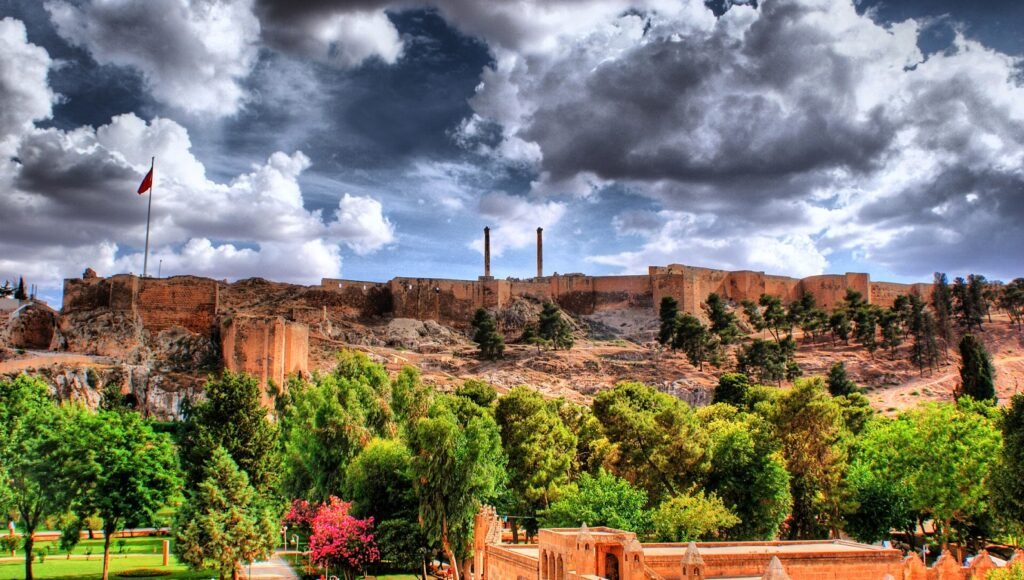
Sanliurfa Castle is built on a Neolithic site with traces of life dating back to 10,000 BC. The 11,500-year-old Balikligol Statue, excavated nearby and displayed in the Sanliurfa Archaeology Museum, along with the castle area, reveals the history of the Balikligol basin. The earliest records of the castle date back to the 11th century. Initially constructed during the Abbasid period between 812-814 AD, the castle is surrounded on three sides by a rock-cut moat.
Cimdin Castle (Çemdin Kale – Old Castle) Sanliurfa
Located in the Viransehir district, this historic castle was likely built for defense and accommodation purposes during the Ayyubid period (1182-1239). Like Sanliurfa Castle, it is surrounded on all sides by a deep rock-cut defensive moat.
The Cradle of the First University: Sanliurfa
Harran Madrasa in Sanliurfa
Harran Madrasa, known as the world’s oldest university, was a prominent center of learning during the golden years of Islam. It was an intellectual hub for Sabians, Syriacs, Christians, Muslims, and scholars of various other faiths. Its most significant contribution to humanity was the translation of ancient Greek works into Arabic, preventing their loss. Today, the remnants of the madrasa, which declined following the Mongol invasions, can still be seen in Harran.
Halil-ur-Rahman Madrasa in Sanliurfa
Located west of Balikligol, the Halil-ur-Rahman Madrasa was built in 1775. It has an “L”-shaped plan and is constructed with finely cut stone. It is believed that the spring feeding Balikligol is located beneath this madrasa.
Rizvaniye Madrasa
The Rizvaniye Madrasa surrounds the courtyard of the Rizvaniye Mosque, northeast of Balikligol. According to its inscription, it was built in 1736 by Ridvan Ahmet Pasha, the Governor of Raqqa, during the Ottoman Period.
Nakibzade Madrasa
The Nakibzade Madrasa, located east of the Ulu Mosque, was built on the site of the no-longer-standing Ayyubid Madrasa. Constructed in 1781 by Nakibzade Haci Ibrahim Efendi, it was used as a primary school for a time during the Republic Period.
Sanliurfa as a Trade Center
Customs Inn
Located in the khan district, this two-story inn now houses tea houses in its courtyard. Built in 1563 by Halhalli Behram Pasha, the governor during the Ottoman Period, it is mentioned as “Yetmis Hani” in Evliya Celebi’s “Book of Travels.” It’s also known as “Alaca Han” due to the two-colored cut stones covering its exterior. The inn’s entrance iwan is used as a mosque, and Balikligol’s water flows through its courtyard.
Mencek Inn
Currently used as a workplace by tailors and haberdashers, Mencek Inn is mentioned for the first time in a 1716 deed. It has an entrance in the form of a vaulted corridor, built with finely cut stones. The square courtyard has covered shops on the east, west, and south sides, and two shops on the north.
Haci Kamil Inn (Çukur Inn)
Used by fabric and tailor tradesmen, this inn is one of the beautiful examples of Ottoman inns in Sanliurfa. Known locally as “Çukur Han” because it is a few steps below ground level, its inscription states it was built in 1823.
Samsat Gate Inn
Adjacent to the now non-existent Samsat Gate, this inn, mentioned in Evliya Celebi’s “Book of Travels,” was constructed with cut stones.
The Culinary Tradition of Sanliurfa
The Dining Culture and History in Sanliurfa
In the rich Turkish cuisine, which stands among the world’s important culinary traditions, the Eastern and Southeastern cuisine, especially that of Sanliurfa, holds a unique place. Influenced by various cultures and nations, Sanliurfa’s cuisine is famous for distinctive dishes like “Tirit,” “Cig Kofte,” “Keskek,” “Jewish Meatballs,” “Sillik,” “Kubu Lebeni,” and “Borani”
A characteristic of Sanliurfa’s dishes is the liberal use of spice, especially chili. In fact, in this region, dishes like lahmacun and cig kofte represent a sort of “spice endurance test” or challenge.
The Role of Isot in Sanliurfa Cuisine
Isot, a type of chili pepper, holds a special place in Sanliurfa’s cuisine. It’s not only a symbol of the city, officially registered in Urfa’s name, but also a significant source of income for the local community.
The people of Sanliurfa place great importance not only on cooking but also on sharing their meals, following in the footsteps of Prophet Abraham, who never dined without guests. This tradition, the origin of the phrase “Halil Ibrahim’s Table,” continues to be upheld by the people of Sanliurfa today.
Urfa Kebab of Sanliurfa

Urfa Kebab is the first thing that comes to mind when mentioning Sanliurfa in Turkey. It is made from minced lamb or mutton mixed with salt, red pepper, and chili powder. Despite the significant role of spice in Sanliurfa’s cuisine, Urfa Kebab is notably not spicy.
Mirra (Bitter Coffee)
Mirra, a type of coffee unique to Arab culture, is widely consumed in Turkish cities like Adana, Mardin, and Sanliurfa. Deriving its name from the Arabic word “mur,” meaning bitter, mirra lives up to its name as one of the world’s strongest coffees. Often referred to simply as “bitter,” the preparation, serving, and drinking of mirra follow specific traditions. Mirra is labor-intensive to make, involving brewing the coffee several times.
Sira Night of Sanliurfa
An indispensable tradition of Sanliurfa folklore, Sira Night (Sıra Gecesi )involves groups of friends, usually of similar socio-economic status, gathering weekly at one another’s homes in the evening, following a specific format and order. This tradition, still alive today, is not just about music. Sira Nights also serve as social gatherings where various topics are discussed, akin to a form of community education.ŞANLIURFA’DA DOĞAL HAYAT
The Northern bald ibis in Sanliurfa
Northern bald ibis , a bird species under the threat of extinction, can only be found in the Birecik district of Sanliurfa and in North Africa. These migratory birds, with an average lifespan of 25-30 years, nest on the cliffs of Birecik in mid-February and leave the district around mid-July, after the breeding season. They spend winters along the Red Sea coasts and have been under protection since 1977 at the Kelaynak Breeding Station established by the General Directorate of Forestry in Birecik.
Birdkeeping
Birdkeeping is a popular hobby and pastime among the people of Sanliurfa. “Birdkeeper Coffeehouses” in the city are gathering spots for bird enthusiasts. The “Çardaklı Coffeehouse” is a must-visit place for bird lovers coming to Sanliurfa. The city is also known for having the highest number of pet birds in Turkey.
Gazelles
Gazelles, native to North Africa and the Middle East, are found in the Ceylanpinar district of Sanliurfa and its surroundings in Turkey. These endangered species are under protection. A conservation area spanning 26 hectares has been established within the Ceylanpinar Agricultural Enterprise.
Horse Breeding
Horses, domesticated in Central Asia, have been one of humanity’s most valued companions throughout history. Sanliurfa is a center for Arabian horses, the dominant breed in the Middle East. The city has an approximate total horse population of 20,000. Sanliurfa, which hosts a branch of the Turkey Racehorse Breeders and Owners Association, is one of the six cities in Turkey where official horse races are organized. Visitors interested in horse racing can experience the thrill at the Sanliurfa Hippodrome.
The Tranquil City of Halfeti in Sanliurfa

Halfeti, located on the banks of the Euphrates River in the west of the province, is one of Turkey’s nine Cittaslow cities. A part of the district is submerged under the waters of the Birecik Dam. Boat trips from Halfeti, lasting about an hour, lead to the submerged historical village of Savaşan and the ruins of Rumkale in Gaziantep.
Black Rose
The black rose, which grows exclusively in Halfeti, is also the symbol of the district. The rose appears black in bud form and turns dark red later. These unique roses attract significant interest from tourists and visitors.
Kantarma Inn
Located in Kantarma Hamlet, the exact construction date of the inn is unknown. Known as the “Seljuk Inn” by the locals, this medieval structure is a mixed-type inn with a courtyard and a covered section.
The Crossroads of History: “Harran” – A Melting Pot of Religions, Civilizations, and Cultures
Harran – Sanliurfa
Mentioned as “Harranu” in an Ebla tablet dating back to 2300 BCE and remaining unchanged for 4300 years, Harran, one of the oldest settlements of the Fertile Crescent, has hosted numerous civilizations, cultures, and religions ranging from the Assyrians and Babylonians to the Persians, Macedonians, Romans, Sassanids, Islamic conquerors, and Crusader states. Harran’s foundation is linked in Islamic history either to Canaan, a grandson of Prophet Noah, or to Haran, the brother of Prophet Abraham. The Old Testament states, “Terah had lived 205 years; he died in Harran.” (Genesis 11:32)
Harran Mound
Located in the center of the city, Harran Mound, which showed no signs of life before excavation, has been inhabited since 3000 BCE to the 13th century CE. The discovered architectural remnants trace multiple eras, particularly revealing a large city during the Islamic period, complete with roads, houses, wells, mills, and sewage systems. Pottery, ornaments, stone tools, animal figurines, and numerous Islamic coins found during excavations are displayed in the Sanliurfa Archaeology Museum.
Harran’s Conical Domed Houses
Synonymous with Harran, the “conical domed,” “cone-shaped,” or “beehive” houses, known to have been used since 6000 BCE, still stand today, with the oldest surviving ones being 150-200 years old. Made of earth, these dome houses are notable for being cool in summer and warm in winter. These fairy-tale-like houses can reach up to 5 meters in height.
Harran’s City Waters and Gates
The ancient city walls of Harran, encircling the city center, are 4.5 km long and about 5 meters high. Historically, the walls had 6 or 7 gates, with only the Aleppo Gate surviving to the present day. The walls, with their 187 towers and cut stones, are a sight worth seeing.
Harran Castle in Sanliurfa
The Inner Castle, located in the southeastern part of the city, forms a part of the walls in that section. There are references to a Sabian temple on the site of the castle. The irregular rectangular, three-story castle, with 150 rooms and a dodecagonal tower on each corner, is thought to be the palace built by Umayyad Caliph Marwan II in Harran. Rare Islamic period artifacts found in the castle are partly displayed in the Sanliurfa Archaeology Museum.
Han el Ba’rur Caravanserai
Located near Göktaş village, 26 km southeast of Harran, this caravanserai dates back to the 13th century and carries all the characteristics of Anatolian Seljuk caravanserais. Its name, “Ba’rur,” meaning “goat dung” in Arabic, comes from a legend that the builder filled it with dried grapes, prophesying that those who came after would fill it with goat dung, which indeed happened as it was used as a stable for many years. The structure has been restored by the Ministry of Culture and Tourism and opened for tourism.
Shepherd Caves (Hermit Caves)
Located on the right side of the Harran-Han el Ba’rur road at the 14th kilometer, there are 10 caves in a row, facing north. These caves, thought to be rock tombs from the Roman period, are speculated to have been built as shelters for shepherds in the Tektek Mountains due to the lack of nearby settlements.
Bazda Caves in Sanliurfa
Historical stone quarries can be found on both sides of the Harran-Han el-Ba’rur road, starting at the 16th kilometer. The Bazda Caves isalso known as “Albazdu,” “Elbazde,” or “Bozdağ Caves”. They are located on the right side at the 19th kilometer. Inscriptions in Arabic on the rocks reveal the names of some quarry operators. The area has been extensively quarried for hundreds of years for Harran, the City of Shuayb, and Han el-Ba’rur, resulting in numerous plazas, galleries, and tunnels in both caves, some as high as 10-15 meters.
Soğmatar Ancient City in Sanliurfa
Firstly, located 57 km from Harran on the Harran-Eyyubnebi Tourism Route, Soğmatar, dating to the 2nd century CE Roman period, is a cult area. The site includes a cave worshiped for the Moon god Sin, a hill with god reliefs and inscriptions on its slopes (Sacred Hill), six square and circular plan mausoleums (monumental tombs), an inner castle, and numerous rock tombs carved into the main rock. Notably, Soğmatar is rich in Syriac inscriptions, and Moses’ Well is also located here.
Senemigar (Senem Cave-Sanem Cave)
The remains in the cave in Mığar village, north of Soğmatar, indicate its significance in the early centuries of Christianity. A three-story monumental structure on the hill in the village is speculated to be either a monastery or palace ruins. While Soğmatar was a center for pagans, the Senem Cave was likely an important site for Christian Syriacs in the region.
If You’re in Sanliurfa, Don’t Miss:
- Balikligol and Aynzeliha Lake:
Experience the tranquility and historical significance of these iconic sites during your stay in Şanlıurfa. - Gobeklitepe:
Visit the world’s oldest known temple, a UNESCO World Heritage Site since 2018, and marvel at the roots of human history during your stay in Şanlıurfa. - Caves of Prophets Ibrahim and Job:
Explore the cave believed to be the birthplace of Prophet Ibrahim and the cave where Prophet Job suffered his illness during your stay in Şanlıurfa. - Mystical Streets of Sanliurfa:
Roam in the enigmatic alleys of Sanliurfa, visiting ancient mosques, madrasas, temples, and churches that echo thousands of years of history during your stay in Şanlıurfa. - Sanliurfa Castle:
Enjoy the panoramic city views from the castle and appreciate the historical landscape during your stay in Şanlıurfa. - Historic Bazaars:
Shop in the historic markets, immersing yourself in the vibrant local culture and craftsmanship during your stay in Şanlıurfa - Harran:
Discover the ancient city of Harran, a former capital to many civilizations and home to one of the world’s earliest universities during your stay in Şanlıurfa - Halfeti:
Take a boat trip in the partly submerged town of Halfeti and witness the unique beauty of the black roses during your stay in Şanlıurfa - Museums:
Explore museums showcasing ancient artifacts and some of the world’s earliest mosaics, revealing the rich cultural and historical heritage during your stay in Şanlıurfa - Legendary Local Cuisine:
Savor the legendary tastes of the city, from Çiğ köfte to Mırra. You must experience a traditional Sira night during your stay in Şanlıurfa
Before leaving, ensure you’ve immersed yourself in the rich history, culture, and flavors that Sanliurfa uniquely offers.

